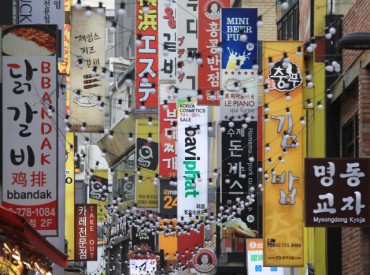
South Korea’s exports plunge 15.8 percent on-year in October. The Gamman Container Terminal in the Port of Busan in the above image. (Image courtesy of Yonhap)
SEOUL, Nov. 1 (Korea Bizwire) –South Korea’s exports contracted at the steepest rate in six years in October as outbound shipments backtracked for the 10th straight month this year, the government said Sunday.
Outbound shipments came to US$43.47 billion last month, down 15.8 percent from the same month last year, the sharpest drop since a 20.9 percent plunge tallied for August 2009, the Ministry of Trade, Industry and Energy said.
It said despite the negative growth, the country’s trade surplus remained in the black as imports slipped at a faster pace. Imports fell 16.6 percent on-year to $36.78 billion.
The country’s trade surplus for the month stood at $6.69 billion, down from $8.9 billion tallied the month before. October also marked the 45th straight month Asia’s fourth-largest economy posted a trade surplus.’
The ministry said the drop in exports was due to the decline in both prices of products and volume of products shipped abroad.
In October, the average price of South Korean goods sent overseas backtracked 7.1 percent on-year, slowing from a 13 percent drop in the previous month.
The drop in prices largely stems from weak global raw material prices.
The average price of Dubai crude, which accounts for some 80 percent of South Korea’s overall oil imports, fell from $86.8 per barrel in October 2014 to $45.8 per barrel last month, according to the ministry.
Consequently, the average price of outbound South Korean petroleum and petrochemical products in terms of value plunged 41.4 percent and 21.4 percent on-year, respectively. Refined petroleum and petrochemicals make up a large part of the country’s exports.
Exports, in terms of total volume, plunged 9.4 percent on-year last month, a turnaround from a 5.3 percent rise in September, the ministry’s latest data showed.
Besides refined petroleum and petrochemicals, exports of cars, steel and ships all fell as global demand weakened, the monthly tally said.
Car shipments were hurt by drops in demand from emerging markets, while steel numbers moved down in the wake of weak unit prices. Automobile exports were down 1.3 percent, while steel dropped 29.6 percent. Ships, another key export, nosedived 63.7 percent on-year.
On the plus side, demand for mobile communication devices, including smartphones, spiked 42.1 percent on-year.
“Sales of models, such as the Galaxy Note 5, the Galaxy S6 Edge and LG’s V10, all pushed up numbers,” the ministry said.
Besides smartphones, exports of solid-state drives and organic light-emitting diodes shot up 25 percent and 29.1 percent on-year, respectively. Exports of cosmetics were also up 30.7 percent.
By region, exports to all major trading partners were down compared with the year before.
Numbers for China, South Korea’s No. 1 overseas market, fell 8 percent, with Japan and the United States declining 25.6 percent and 11.4 percent, respectively.
Exports to the European Union fell 12.5 percent, with the Association of Southeast Asian Nations (ASEAN) backtracking 12.6 percent.
Shipments to Vietnam, part of ASEAN, rose 12.7 percent, mainly due to parts and components shipped to the Southeast Asia country to make products for exports.
On imports, the country’s imports of raw materials tumbled 29 percent on-year, while imports of consumer and capital goods gained 13.8 percent and 20.9 percent, respectively.
By products, steel product imports fell 24.1 percent on-year, with crude oil nosediving 44.5 percent.
Imports of mobile communication devices soared 84.3 percent on-year, with liquid crystal displays moving up 4.5 percent.
The ministry forecast the country’s exports to continue to stay in minus territory in November, although the pace of decline may lessen as local shipyards are expected to turn over more new vessels to their owners.
It added that since international oil prices started falling sharply after October of last year, trade volume numbers that have been swayed by commodities prices should start falling less in the coming months.
It said every effort will be made to diversify export markets and alter the types of products being exported. It said concerted efforts will be made to build up the cosmetics and pharmaceutical sectors that are showing growth potential.
Despite such measures that will be taken by the government, local market watchers said trade conditions may not improve in the near future as the Chinese economy will likely be gripped by sluggish growth and uncertainties are mounting over the expected move by the U.S. Federal Reserve to mark up interest rates within the year.
“The domestic economy is clearly on the mend, but prospects for exports are not that good at the moment,” an economist said.
Supporting such views, the business survey index (BSI) for the country’s manufacturing sector released late last week by the Bank of Korea dipped to 80 from 81 reached in September.
A reading below 100 means pessimists outnumber optimists.
The same report showed that the BSI for export in November stood at 81, down 3 points from the forecast for October.
(Yonhap)






